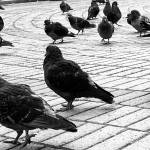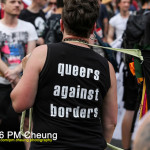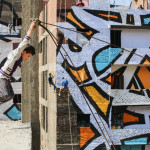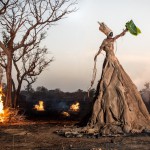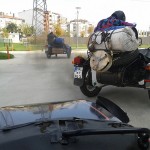Art in Public Space
Marlene KadgienFebruary 16, 2023Thomas Geiger studied Fine Arts in Karlsruhe and Interdisciplinary Art in Tallinn, Estonia and is now settled in Vienna as a performance, sculpture and language artist with a focus on public space.
He is currently in Istanbul for a 3-month stay as part of the International Residency Program of the Austrian Cultural Ministry accompanied by the Austrian Cultural Forum Istanbul and Diyalog.
Co-financed by the Goethe-Institut, he was invited to the “Arter” Museum, one of the most renowned art houses in Istanbul, to present his performance “The Pigeon“, adapted to Turkish public space.
However, under the current conditions, triggered by the terrible earthquake in southern Turkey, Kurdistan and northern Syria, the performance has been cancelled until further notice.
Geiger plans to realise the performance in another house or place in a respectful way towards the earthquake.
In his performance “Le Pigeon” (The Pigeon), first realised in Paris, Thomas Geiger shifts the perspective of the recipient and focuses on the omnipresent pigeon in public space. In doing so, he gives a voice to the expert for this space, as Geiger calls the pigeon, in order to draw attention to its living space, which is threatened by privatisation.
In the continuing version in Istanbul the pigeon is to remain the protagonist as a recurring character, sharply criticising and questioning the advancing privatisation, which is often only distinguished from private space by only fences or walls.
In this way, he places objects of everyday life and daily perception in a slightly shifted context and encourages the recipient to rethink the prevailing structures.
In his new project “Istanbul Simit Exchange”, Thomas Geiger plans to buy a vendor’s daily supply of simits and offer them to pedestrians for free. In return, he invites them to draw their own simit on a sheet of paper as a value compensation. As is well known, the steadily decreasing purchasing power of the Turkish lira can be illustrated by the price of simits and underlines the ever-shrinking, affluent middle class and ever-increasing poverty in Turkey. The basic idea of the project is to take up and critically question the issue of value representation and the payment for creative work. So you don’t pay for your simit with money, but with a small, creative, self-produced piece of work. These creative imitations of the simits will then be sold in Vienna as components of his project “I want to become a millionaire”, which has been running since 2010.
The performance was canceled because of the earthquake that took place Feb 6 in Turkey and Syria. Instead the artist will prepare a video of the performance which will be screened later on. Watch out for further notification. [...]
Read more...
Shuqin GuanAugust 3, 2022The capital of Bulgaria – Sofia – is full of an artistic atmosphere this summer. Wandering in the lush green public gardens of the city, you will easily encounter art.
At the Sofia City Garden and at the Crystal Garden you find two different exhibitions.
Exhibition in the City Garden | Madam Architect
You should definitely have seen the exhibition Madam Architect in the City Garden last July.
Madam Architect traced the work of female architects in Bulgaria and Germany. This exhibition presented twenty wonderful portraits of women who have contributed to architecture in both countries throughout the twentieth century. Like many other professional spheres, in architecture, women had to fight their way in a hostile environment to prove their talent and earn the right to an education and to a professional career.
Madam Architect was presented in Sofia by the Goethe-Institut, Bulgaria and the Bulgarian Modernist Architecture foundation.
The first section focused on German female architects and started the narrative by Emilie Winkelmann, the first freelance architect in Germany that ran an independent architecture practice in 1907. Many of the buildings designed by her, most of which were adapted to the individual needs of the residents, are now under historic preservation.
The timeline of this part of the German section spans German history since 1900, the Kaiserreich, the interwar years, the Third Reich, as well as the division of Germany and its reunification in the 21st century.
The Bulgarian section, on the other hand, only includes the years between the two world wars, and it is from this period that women were allowed into the conservative male sphere of architecture. Women in the construction industry faced a particularly unfriendly environment, which made it difficult for them to demonstrate their skills and earn access to educational opportunities and professional positions.
This exhibition explores the liberation movements of the 20th century, focusing on gender politics in particular. By breaking into traditionally male-dominated professions, getting involved in politics, and experimenting with new gender roles, women entered into modernism in which class, gender, knowledge struggles, senselessness, and alienation are all part of the conversation.
A focus of the exhibition is the past and present of women architects, their achievements in architecture, their lives, and their struggle to survive. A wide range of archival materials is displayed in the exhibition, including portrait photographs, hand-drawn projects, floor plans, sketches, and decorative drawings. By putting faces to names and sharing their experiences, these women in architecture are no longer anonymous and can voice their ideas.
The world’s female population is approximately 50%, and as equal stakeholders, their voices must be heard and encouraged. In this context, by highlighting the experiences and pursuits of these remarkable female architects, it is not only motivating other women to explore their own roles but also shedding more light on the present difficulties of gender equality in the workplace. Such a review of the past is also a good tool to better understand the present and future. Does the situation still exist? Why does this still happen? What should we do to voice and fight? How can we make them visible? Maybe these are the questions we should ask.
Exhibition in the Crystal Garden | The Beauty of Croatia
A photography exhibition opened at the Crystal Garden on a fine Monday afternoon, July 11. Presenting 26 amazing artworks by Croatia photographer Marko Vrdoljak, who has worked for many years on promoting the beauty of Croatia to the world.
The beauty of Croatia exhibition is one of the activities to commemorate the 30th anniversary of establishing bilateral diplomatic relations between Bulgaria and Croatia. With 26 images from around Croatia, the exhibition narrates a story of world-famous places and lesser-known locations. Providing a glimpse into the culture, history, and natural heritage of a relatively small country.
Experiencing some tough times and restrictions during the pandemic, these exhibitions also give fresh energy to the communities and inspiration for people enjoying their summertime. [...]
Read more...
Thomas BüschAugust 9, 2018
Utopian Nights in Malta includes a series of public events which bring artists and thinkers together to discuss important social issues related to exile and conflict.
The Utopian Nights will take place over the course of four themed events during 2018 and are part of the cultural programm Valletta 2018 Cultural Capital, where experts will engage the public with artistic interpretations of pressing political themes.
All sessions will include an open debate with experts and an invitation for public feedback, followed by the opportunity to continue discussion during a social mixer event.
The catalyst of the series is the notion of a utopia, which is envisaged as a democratic space – a platform for discussion and a participatory project in which everyone can debate, challenge and be challenged equally.
Utopian Nights – Inside the Border took place from the 1st August to the 5th August 2018 at Howard Gardens, Mdina Malta. Through an array of activities, including debates, storytelling, an open-air cinema, photo studios, street performances and a Spoken Word concert, the public was invited to explore the tangible and intangible borders that cut through and fragment our world today.
With author and musician Fattima Mahdi from London and her partner DJ Shays from Abuja! A blend of Soul, Funk and Afrobeat. With a performance by the Tunisian artist Lilia Ben Romdhane and the Maltese artist Magerita Pule.
Video by Mohamed Ibrahim, Malta [...]
Read more...
David SiegelMay 9, 2018There is a bit of Darwin to Katharina Swoboda’s lions. An origin of a species of lion, one might say, migrating and changing despite being made of stone. The Lion of Atlanta: a Research Story explores the one of the distant relatives of the Lion of Lucerne, which has made its home in Atlanta, USA since 1894.
Swoboda’s film is a purposefully incomplete tapestry. One that is an enchantingly strange patchwork, which captures the lion’s survival and fitness wonderfully following its creation as a monument to confederate soldiers from the American Civil War. The 124 year-old lion’s environment is a fascinating mixture of ghosts, graveyards, changing allegiances, living lions, hollywood elites, and classic literature.
The often eerie atmosphere and cuts seem to amplify the disembodied nature of a radically shifting area in a relatively short historical timeline. The Lion of Atlanta must too be disembodied to be properly suited to the space. Further supported by the film’s audio, Swoboda plays with evocative acoustic contrasts. The research story shifts between pop songs and songs of American history. Additionally, the narration moves between European accented English and a native speaker. Two subtle and interesting ways suggesting of the lion’s lineage and changes over time.
Lucky for us, there is an upcoming prologue and an epilogue. We look forward to Swoboda’s findings as she travels to distant shores as the lion before her. It leaves us wondering: is she the Lioness and what would Darwin have to say about these transformations?
The Lion of Atlanta: a Research Story is currently showing at “Löwen Safari.” The exhibition is curated by Peter Fischer at Kunsthalle Luzern in Switzerland.
The video was produced as part of L21 «Lion Monument 21» A Multi-Annual Project by Kunsthalle Luzern 2017-2021, which deals with the Lion Monument in Lucerne. More information on the project can be found at:
About L21 [...]
Read more...
Thomas BüschJune 27, 2016June is designated as Gay Pride Month for the lesbian, gay, bisexual and transgender community and celebrations are held throughout the world to honor the impact that lesbian, gay, bisexual and transgender individuals have had and will continue to have on history.
Hundreds of thousands of people from New York to San Francisco marched to celebrate gay pride, honor those killed in the Florida gay nightclub massacre, and promote tolerance.
The event is not just about celebrating the lesbian, gay, bisexual and transgender community – it is an overall symbol for love and acceptance, as these happy couples prove.
Istanbul’s 14th Pride Week got banned due to ‘security reasons’, but lesbian, gay, bisexual and transgender activists and supporters still tried to gather and spread all around Taksim to carry out their annual celebrations. Police forces used tear gas and rubber bullets to disperse the crowds.
Police on Sunday rounded up several activists in Istanbul who assembled on a main pedestrian street to issue a statement in honor of gay rights and to denounce the ban. Police later fired tear gas and rubber pellets to disperse activists gathering in side streets. Two European Parliament legislators were also briefly detained.
Celebrators in New York caught a glimpse of the potential next president of the United States Sunday when she appeared, unexpectedly, alongside New York Gov. Andrew Cuomo and NYC Mayor Bill de Blasio in the city’s pride parade. Clinton greeted paradegoers as she walked along a portion of the route.
Pope Francis said that the Catholic Church should ask gay people for forgiveness:”I think that the Church not only should apologize … to a gay person whom it offended but it must also apologize to the poor as well, to the women who have been exploited, to children who have been exploited by work.” Francis told reporters when asked if the church should express remorse for its treatment of homosexuals. He reportedly looked sad that that apology became more urgent after the mass shooting in Orlando earlier this month.
[...]
Read more...
Thomas BüschApril 8, 2016The more you go to the East, the more you reach the West.
The Tunisian-French street artist eL Seed has created his new piece of work “Perception” in the neighborhood of Manshiyat Nasr in Cairo, where the Coptic community of the so-called Zabaleen – garbage people – live, they clean the city of Cairo. The artwork is extended over 50 buildings and was created in total secrecy from the Egyptian government.
The artist was born and raised by his Tunisian parents in France and first learned to read and write in Arabic when he was eighteen years old. He calls his mix of graffiti and Arabic calligraphy “Calligraffiti”, which is not restricted by the rules of Arabic calligraphy but rather more his interpretation and recreation of it. With returning to his routes and his quest of identity he is aiming to invite people to his language, culture and art to promote tolerance between the people and break down stereotypes of the Arabic world, and in light of Arabic spring, to comment the changing world order.
All around the world he could realize his works, always with messages that speak to the local community within the beauty of calligraphy but with the language of the youth.
Calligraffiti in York City: “The more you go to the East, the more you reach the West.”
“Perception” is not his first famous work. In 2012 he achieved a certain claim of fame for the painting of the minaret of the Jara Mosque in the southern Tunisian city of Gabes. In the birthplace of the Arab spring, eL Seed is in line with many other street artists facing the restrictions of the revolution through the demanded freedom of art. In an interview with the Crimson Magazine he stated: “When you paint on the street, it’s like you’re taking back the public space. Why do they call it public space if you can’t paint in it?”
‘Anyone who wants to see the sunlight clearly needs to wipe his eye first.’
‘إنأرادأحدأنيبصرنورالشمس،فإنعليهأنيمسحعينيه’
This sentence is quoting the Coptic bishop Athanasius. Before realizing his completely self-funded work he had to confess the priest of the Coptic neighborhood. Within three weeks and a big team he finished the piece, which can only be seen in its whole from a certain view of point of the Moqattam Mountain nearby. The wall is for him just the pretext to open conversation in the public thus challening variety and change perception to lead to positive encounters between different people, cultues and nationalities. Because what you think always depends on the view of perspective.
[...]
Read more...
Josefine BerkholzNovember 3, 2015For his latest photography-project Prophecy, Fabrice Monteiro created ten mythological-futuristic statues out of trash, each of them pointing out to a striking environmental problem.
When Fabrice Monteiro started out in photography his initial focus was in fashion-photography.
But the Dakar-based belgian-beninian artist and former model soon realized he wanted to extend the field. He experimented with the lines between fashion and more socially dedicated photography to create pictures that interrogate both the viewer and the world around himself, pictures the viewers would get more involved with.
In the last years, his works focused on tough political topics such as slavery or the history of colonialism in his home-country Benin. And the African continent – it’s socio-politcal issues as well as it’s cultural heritage and traditional riches – are definitely a matter he keeps coming back to.
For his latest project „ The Prophecy“, he cooperated with Senegalese fashion designer Drousy to create ten colossal figures made entirely from trash collected throughout the country. Each of these „Jinns“ – supernatural giants – focuses on a mayor environmental issue in Senegal, most of them relevant in other african countries as well. They are installed and … shot in spots seriously endangered by pollution: a beach through which blood and entrails from a close-bye slaughterhouse are led into the ocean, a coastline covered in black plastic bags, Senegal’s largest waste dump.
The Jinns are inspired by the greek mythological figure of Gaia – personification of mother earth – and bring together futuristic fashion design and imagery from traditional storytelling. This way, Monteiro approaches the subject in a rather narrative than didactive way. By somehow personificating the problem and at the same time building up a hero-like statue that stands within – or may be against it – he lifts the issues focused to a very tangible level.
“The Prophecy” clearly points to the very striking problem of a rich natural heritage sacrificed to consumerism and economic interests. It’s ambivalence in aesthetics and approach is quite representative for Monteiro, who explored the gaps between different artistic languages as well as the two cultures that he grew up in in earlier works. It has been financed via crowdfunding with support of the green network EcoFund and is currently exhibited in the Louisiana Museum of Modern Art. [...]
Read more...
Thomas BüschAugust 9, 2015
The idea of Artist Placement stemmed from a group of UK artists, and was guided by John Latham and initiated by Barbara Steveni, who were experimenting with radical new forms of art.
Between 1966 and the mid-1980s, APG negotiated approximately twenty placements on behalf of artists in industry and government. Unlike most residency schemes that have emerged in its wake, APG artists were not required to produce any determinable object as a result of her or his placement.
The goal was not to put the artist at the service of industry or government, but to allow her or him to act upon a given situation outside of the studio and the art market, in an environment usually perceived as alien to intuitive, creative thinking. As APG’s axiom put it: ‘Context is half the work’. It was understood that the benefits of the placement, for the artist as well as for the host organisation, would most likely be felt over the long term, affecting both parties in ways difficult, if not impossible to quantify. In the short term, signing on to APG’s open brief represented a considerable gamble on the part of organisations having to justify any investment perceived as ‘risky’.
The APG display at Artefact features facsimiles of correspondence between APG and potential host organisations, most of which did not lead to an actual placement. These are selected from the Tate Archive and Steveni’s personal papers. Together they constitute a ‘hidden’ history of APG – which may well be its most accurate, given its emphasis on process and language over object-production. But the display is not merely historical: it points to the effort required – today as much as in the 1960s and 1970s – to convince the private and public sectors of the intangible and unpredictable value of an artist’s insight.
APG was a milestone in Conceptual Art in Britain, reinventing the means of making and disseminating art, and anticipating many of the issues facing cultural workers today. It represented itself in a number of exhibitions and events, notably in the exhibition Art and Economics at the Hayward Gallery in 1971 with artistic interventions by Garth Evans, Barry Flanagan, John Latham and others. Emulating APG’s emphasis on the discursive, the exhibition will host frequent public discussions relating to art and social organisation.
An exhibition at Kunstraum Kreuzberg in Berlin presents six selected placements opening on September 12th, with research material, artworks and a documentation of the APGs activities in the UK and Germany.
[...]
Read more...
Thomas BüschJune 26, 2015For decades graffiti has been causing judical issues now. Most of this artworks are being created on walls that do not belong to the artists and mean a massive annoyance to many house owners and municipalities. Heaps of investigations and trails derived from this style of art all around the world so far. In New York things now go the other way round: Artists are currently suing a house owner for destroying their works.
The walls in question belonged to the 5Pointz Aerosol Art Center in Long Island City, New York, and has already been teared down. In 2004 Jonathan „Meres One“ Cohen was given keys to the building owned by Jerry Wolkoff and his company G&M Realty. During the following years the facade became colourful: Artists such as Maria Castillo (TOOFLY), James Cochran (Jimmy C), Luis Gomez (Ishmael), Bienbenido Guerra (FCEE) and Kai Niederhausen (Semor) sprayed the walls with their writings. Like this 5Pointz became a unique urban piece of art.
In 2013 a longer law trail ended with the house owners creating precedents: Just over night they whitewashed the whole building. All the art works were destroyed by white paint just sprayed onto them, nothing remained. Hundreds of people joined a rally to protest against this demolition, but there wasn’t anything left to do. For the protesters the whitewashing did not make sense: The demolition of the 5Pointz site was already planned by then and would have happened some months later. Time, the artists would have liked to use for preservation of their works.
Now the affected artists are demanding restitution for their losses caused by Wolkoff’s whitewashing action: They filed in a complaint in federal court in Brooklyn this month. The group is claiming that „the destruction was gratuitous, willful, and wanton, and undertaken without regard to the feelings, reputations, or financial interests of the plaintiffs“. They complain about not being given any chance to remove or preserve their works before their ultimate destruction.
With this urban art scene is facing a new dimension of the judical questions: The judges will have to decide whether graffiti writings become acknowledged artworks. Do they derserve protection, regardless of the wall’s owners opinion? There are interesting times coming up at Brooklyn Federal Court.
And by the way: At the site, where 5Pointz used to be located, now is a construction site. G&M Realty is building – what a surprise – luxury apartments there.
[...]
Read more...
Katharina SchmidtFebruary 3, 2015The Street Art Scene in Istanbul is constantly growing – for the most part thanks to the annual Street Art Festival Istanbul. Founded in 2007 by the artist Pertev Emre Taştaban it attracts street artists from all over the world who stay in the city for a couple of weeks in order to realise their artwork. İn the last two years the festival’s focus was on Yeldeğirmeni, a district belonging to Kadıköy. The quarter located on the asian side of İstanbul is undergoing steady reconstruction. With a lot of artists residing there and the opening of new cafés and shops it is becoming one of the new hip areas of the city. During the festivals, the street artists took advantage of the huge empty murals and covered them with wall-filling paintings.
Starting in the 1980s with a growing popularity of graffity art, street art today stands for a very diferentiated forms of unconvential expression – including sticker art, video projections, street installations as well as very new forms like yarn bombing or lock on sculpture. Inherent to the work as a street artist is worldwide travelling and working: festivals provide one of the main stages for the creation of street art.
It is often called “urban” or even “guerilla art” which implies already its closeness to urban forms of protest: Used on private property without permission it aims at reclaiming the urban space, but the line to vandalism migth be hard to draw. Especially graffity without formal permission is mostly seen as an illegal act.
As it is an art of the urban and non-profitly orientated to directly reaching the public, street art often refers to social problems related to the city and can therefore be used as a form of protest. In the artwork of Yeldeğirmeni one can see references to the Gezi Movement of 2013 as the artists take on symbols of the protest – the gas mask and the penguin. [...]
Read more...
Markus SchmidtOctober 17, 2014
If people don’t come to art, art must come to the people. And if some parts of art are missing the reference to the world, then other areas of the arts must be even stronger to enter into a new dialogue with the world.
ARUNSKI & POET – PENNERGOLD 2
With the above quote Haus am Lützowplatz in Berlin, Germany presents the 11th Interventionale. The show displays not only art in public space but rather more artistic intervention into the public space.
The strategies are subtle and subversive or bold and provocative, the term ranges from political to poetic, from calligraphy to abstract and performative disturbing. Common to them is an intervention into the public, the appropriation of the public and the associated self-empowerment for communication with artistic means.
The 11th Interventionale shows art that is staged in public spaces. And this regardless of the genre and category. The participating artists have one thing in common: their stage is not (only) the White Cube, the gallery or the museum. This art takes place first of all outside, in the city.
Many of the works on display are documents of performances, installations or documents of performances in public space. Other work are able to be shown indoors and outdoors, but all of them have their origins in the public space. Of course there are a lot of good art, which is designed exclusively for the interior. Nothing is absolute. Everything can be. Diversity is what matters.
The artist Friederike Feldmann presents Parole, a wonderful intervention in public space, a rare moment of confusion.
The police moved in to remove Feldmann’s work called speech after only one day of installation at the Oranienburger Street in Berlin Kreuzberg. The fear of the non-readable font and its unknown contents was to big. Is the writing Arabic? Is it an Islamic content? Why the red fabric, why the black font? Does it belong to a terror group? Not the known is fearsome but the unkown, who triggers police! To achieve such an effect with an intervention, can not be planned. It happened because of the uncertainty of the observer who believes he is out of control of a certain situation.
With Penner Gold 2 the artist duo Arunski & Poet presents a video that is the documentation of their performance in public space. The artists and their team toppled 3.600 numbered empty returnable bottles and cans, which are paid each with 25 cents deposit in front of a subway station and then they observed with cameras the reactions of passers-by. First people played football with the bottles, then the needy started to collect the bottles in large plastic bags. The work extrapolates the social reality that is often ignored in everyday life.
Artists:
Arunski & Poet
Clemens Behr
East Eric
EMESS
Friederike Feldmann
Heiko Zahlmann
Haus am Lützowplatz Berlin
Lützowplatz 9, 10785 Berlin
October 18th – December 7th, 2014
[...]
Read more...
Markus SchmidtOctober 9, 2014leavinghomefunktion: 5 People + 5 Ural Motorcycles + 2 Years + 30.000 Kilometres
In September 2014 five young artists from Halle, Germany, started a two-years trip from Germany to New York City on the landway. – They are using old Russian Ural motorcycle going East to get to the West. They will cross 23 borders and will cover a distance of 30,000 kilometres. InEnArt met the five artists on their two-days stay in Istanbul.
Road of Fame
The journey is not a way to get a break of daily life; they intend to get new impulses and they want to exchang experiences with other cultures to overcome clichés and get connected to build up a community. It is their way to broaden their own horzions, get first-hand informations and questioning themselves “how do I handle the situation?”. Through these experiences they want to create a social project. The biggest challenge lies in advantage of rearranging one’s own preceptions of cultural and social space constructions.
That is why we decided to do this in two years to get a deeper insight, mentioned Elisabeth Oertel.
Johannes Fütsch, Sven Klatt and Lisa Müller, Elisabeth Oertel and Anne Knödler
They left their familar terrain entering an adventures of the unknown.
We use the motorcycles as a medium to get in contact with our social environment, said Anne Knödler.
They decided not to be a studio artist but expand their art practice into a mobile and intercultural art project.
Two wheels with sidecar
The Ural motorcycle is a cross-country vehicle which is also used and much appreciated in Georgia, Kazakhstan, Mongolia and Russia. This type of motorcycle with a sidecar is a traditional means of transportation in many places there. It is generally considered robust, anyone can repair it and when necessary they can provide us with spare parts, yet it is said that these machines break down from time to time.
The motorcycle makes the difference
We opted for these old Russian motorcycles since for us the journey itself is the main issue
Follow the Trip
By keeping us up-to-date they are documenting their trip via filming, photographing and writing and publishing it regular at leavinghomefunktion.
The next stop on the trip will be in a small village in Georgia where they are going to stay six-month isolated from the civilization.
[...]
Read more...

